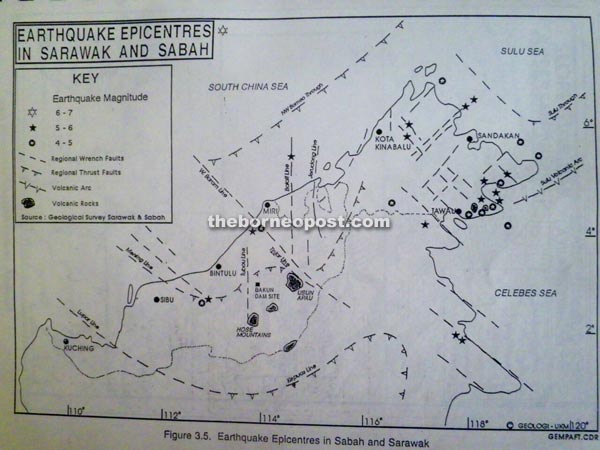
A seismotectonic map showing the fault lines located near the locations where the Baram and Baleh dams have been proposed to be built.

See Chee How
KUCHING: The state government should view the state and its people’s security as of paramount importance and seriously consider the scrapping of both Baram and Baleh dams altogether, bearing in mind the fact that the proposed dams are sitting on earthquake fault lines.
In making this call, Batu Lintang assemblyman See Chee How said a seismotectonic map published in the Bakun HEP Environment Impact Assessment (EIA) Report in 1995 by the Geological Survey Sarawak and Sabah showed that there were fault lines located exactly on the locations where the two dams had been proposed to be built.
“Based on the map, we can see that Baleh and Baram dams are sitting on the fault lines. Baram is serious because the fault line is active and we didn’t know about that earlier (until the fact was revealed by The Borneo Post yesterday). We were looking more on Baleh because there are more fault lines there and Belaga and its vicinity have had experienced numerous counts of tremor over the last few decades, with two earthquakes measured between 3.5 and 3.8 on the Richter scale in 2012.
“We must therefore conduct the seismological studies on this area to check whether the fault lines are active or inactive and the possibility of water-induced earthquake happening with the existence of these fault lines over the areas in Baram and Baleh,” he told a press conference here yesterday.
See was responding to a disclosure by former Sabah Minerals and Geoscience Department director Alexander Yan that a seismotectonic map showing earthquake fault lines in Sarawak drawn up in 2006 by the department showed the site of the proposed Baram Dam was in close vicinity of two fault lines.
“Whether the fault lines are active, they are permanent security risks.”
See said those most at risk are those living downriver from the proposed Baram and Baleh dams.
“It is always a security risk for people living down river. If you’re talking about Rajang River area, it is almost 500,000 people living below the dam. So the government must carry out seismological study to ensure that the dams that are going to be built are at the sites where the people living down the river will not have to live in fear of their safety and security.”
He added: “Once the dams are built, the water bodies there will cause pressure to the fault lines and internationally, we know there are so many examples of the water-induced earthquakes over the areas. The proposed Baleh dam poses particular risk as Bakun and Murum dams are located nearby.”
See said the state government should engage independent experts to carry out the seismological studies on the areas that had been proposed to be built with dams, adding that they should not just be looking at the profit that the state could derive from the dams but more importantly the security of the people living down river of the dams. To a question, he agreed that seismological study results should be included as part of the requirements in the Environmental Impact Assessment (EIA) report for future construction of dams and should be made available everywhere in the state so that everyone who is concerned can inspect and study the report.
“It is highly questionable whether the land mass in Sarawak can sustain and withstand the water weight of the proposed 12 mega dams in Sarawak. This is an area that we should be very concerned with and ensure that our environmental impact assessment studies include seismological studies.”
Meanwhile, PKR national women vice president Voon Shiak Ni appealed to Chief Minister Datuk Patinggi Tan Sri Adenan Satem to order further studies such as seismological study to be conducted in all the areas that had been proposed to be built with dams.
Voon, who is PKR Stampin branch vice chairperson, said such studies were justified so as to give Sarawakians an assurance that their lives would not be at risk.
